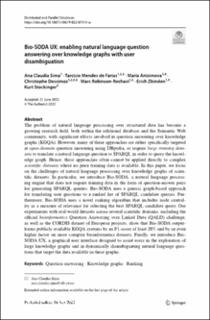Please use this identifier to cite or link to this item:
https://doi.org/10.21256/zhaw-25368Full metadata record
| DC Field | Value | Language |
|---|---|---|
| dc.contributor.author | Sima, Ana Claudia | - |
| dc.contributor.author | Mendes de Farias, Tarcisio | - |
| dc.contributor.author | Anisimova, Maria | - |
| dc.contributor.author | Dessimoz, Christophe | - |
| dc.contributor.author | Robinson-Rechavi, Marc | - |
| dc.contributor.author | Zbinden, Erich | - |
| dc.contributor.author | Stockinger, Kurt | - |
| dc.date.accessioned | 2022-07-27T09:30:39Z | - |
| dc.date.available | 2022-07-27T09:30:39Z | - |
| dc.date.issued | 2022-07 | - |
| dc.identifier.issn | 0926-8782 | de_CH |
| dc.identifier.issn | 1573-7578 | de_CH |
| dc.identifier.uri | https://digitalcollection.zhaw.ch/handle/11475/25368 | - |
| dc.description.abstract | The problem of natural language processing over structured data has become a growing research field, both within the relational database and the Semantic Web community, with significant efforts involved in question answering over knowledge graphs (KGQA). However, many of these approaches are either specifically targeted at open-domain question answering using DBpedia, or require large training datasets to translate a natural language question to SPARQL in order to query the knowledge graph. Hence, these approaches often cannot be applied directly to complex scientific datasets where no prior training data is available. In this paper, we focus on the challenges of natural language processing over knowledge graphs of scientific datasets. In particular, we introduce Bio-SODA, a natural language processing engine that does not require training data in the form of question-answer pairs for generating SPARQL queries. Bio-SODA uses a generic graph-based approach for translating user questions to a ranked list of SPARQL candidate queries. Furthermore, Bio-SODA uses a novel ranking algorithm that includes node centrality as a measure of relevance for selecting the best SPARQL candidate query. Our experiments with real-world datasets across several scientific domains, including the official bioinformatics Question Answering over Linked Data (QALD) challenge, as well as the CORDIS dataset of European projects, show that Bio-SODA outperforms publicly available KGQA systems by an F1-score of least 20% and by an even higher factor on more complex bioinformatics datasets. Finally, we introduce Bio-SODA UX, a graphical user interface designed to assist users in the exploration of large knowledge graphs and in dynamically disambiguating natural language questions that target the data available in these graphs. | de_CH |
| dc.language.iso | en | de_CH |
| dc.publisher | Springer | de_CH |
| dc.relation.ispartof | Distributed and Parallel Databases | de_CH |
| dc.rights | https://creativecommons.org/licenses/by/4.0/ | de_CH |
| dc.subject | Question answering | de_CH |
| dc.subject | Knowledge graph | de_CH |
| dc.subject | Ranking | de_CH |
| dc.subject.ddc | 005: Computerprogrammierung, Programme und Daten | de_CH |
| dc.title | Bio-SODA UX : enabling natural language question answering over knowledge graphs with user disambiguation | de_CH |
| dc.type | Beitrag in wissenschaftlicher Zeitschrift | de_CH |
| dcterms.type | Text | de_CH |
| zhaw.departement | Life Sciences und Facility Management | de_CH |
| zhaw.departement | School of Engineering | de_CH |
| zhaw.organisationalunit | Institut für Informatik (InIT) | de_CH |
| zhaw.organisationalunit | Institut für Computational Life Sciences (ICLS) | de_CH |
| dc.identifier.doi | 10.1007/s10619-022-07414-w | de_CH |
| dc.identifier.doi | 10.21256/zhaw-25368 | - |
| zhaw.funding.eu | No | de_CH |
| zhaw.issue | 2 | de_CH |
| zhaw.originated.zhaw | Yes | de_CH |
| zhaw.pages.end | 440 | de_CH |
| zhaw.pages.start | 409 | de_CH |
| zhaw.publication.status | publishedVersion | de_CH |
| zhaw.volume | 40 | de_CH |
| zhaw.publication.review | Peer review (Publikation) | de_CH |
| zhaw.funding.snf | 167149 | de_CH |
| zhaw.webfeed | Computational Genomics | de_CH |
| zhaw.webfeed | Datalab | de_CH |
| zhaw.webfeed | Data Management and Visualisation | de_CH |
| zhaw.webfeed | Information Engineering | de_CH |
| zhaw.funding.zhaw | Bio-SODA – Enabling Complex, Semantic Queries to Bioinformatics Databases through Intuitive Searching over Data (SNSF NRP 75 "Big Data") | de_CH |
| zhaw.author.additional | No | de_CH |
| zhaw.display.portrait | Yes | de_CH |
| Appears in collections: | Publikationen Life Sciences und Facility Management Publikationen School of Engineering | |
Files in This Item:
| File | Description | Size | Format | |
|---|---|---|---|---|
| 2022_Sima-etal_Bio-SODA-UX.pdf | 2.03 MB | Adobe PDF |  View/Open |
Show simple item record
Sima, A. C., Mendes de Farias, T., Anisimova, M., Dessimoz, C., Robinson-Rechavi, M., Zbinden, E., & Stockinger, K. (2022). Bio-SODA UX : enabling natural language question answering over knowledge graphs with user disambiguation. Distributed and Parallel Databases, 40(2), 409–440. https://doi.org/10.1007/s10619-022-07414-w
Sima, A.C. et al. (2022) ‘Bio-SODA UX : enabling natural language question answering over knowledge graphs with user disambiguation’, Distributed and Parallel Databases, 40(2), pp. 409–440. Available at: https://doi.org/10.1007/s10619-022-07414-w.
A. C. Sima et al., “Bio-SODA UX : enabling natural language question answering over knowledge graphs with user disambiguation,” Distributed and Parallel Databases, vol. 40, no. 2, pp. 409–440, Jul. 2022, doi: 10.1007/s10619-022-07414-w.
SIMA, Ana Claudia, Tarcisio MENDES DE FARIAS, Maria ANISIMOVA, Christophe DESSIMOZ, Marc ROBINSON-RECHAVI, Erich ZBINDEN und Kurt STOCKINGER, 2022. Bio-SODA UX : enabling natural language question answering over knowledge graphs with user disambiguation. Distributed and Parallel Databases. Juli 2022. Bd. 40, Nr. 2, S. 409–440. DOI 10.1007/s10619-022-07414-w
Sima, Ana Claudia, Tarcisio Mendes de Farias, Maria Anisimova, Christophe Dessimoz, Marc Robinson-Rechavi, Erich Zbinden, and Kurt Stockinger. 2022. “Bio-SODA UX : Enabling Natural Language Question Answering over Knowledge Graphs with User Disambiguation.” Distributed and Parallel Databases 40 (2): 409–40. https://doi.org/10.1007/s10619-022-07414-w.
Sima, Ana Claudia, et al. “Bio-SODA UX : Enabling Natural Language Question Answering over Knowledge Graphs with User Disambiguation.” Distributed and Parallel Databases, vol. 40, no. 2, July 2022, pp. 409–40, https://doi.org/10.1007/s10619-022-07414-w.
Items in DSpace are protected by copyright, with all rights reserved, unless otherwise indicated.